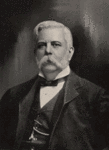George Westinghouse

Westinghouse, George
| Topics: |
George Westinghouse was born in Central Bridge, New York, on 6 October 1846. In his youth he worked in the shops of G. Westinghouse & Co. in Schenectady, where his father manufactured agriculture machinery. It was there that young George acquired a realistic sense of tools, materials, machinery and structures.
After three years of military service during the Civil war, he returned to Schenectady, and in September 1865, enrolled as a sophomore at Union College. Within three months, however, he convinced himself and his teachers the college curriculum had little to offer to one with his mechanical learnings. He dropped out of the college at Christmas vacation and returned to his father's factory. One important thing did happen during his short stay in college: on-October 31, 1865, at age 19, he obtained his first patent, for a rotary steam engine.
While traveling on the trains for his fathers business he observed the problem of derailed cars, and that led to his inventing a device for replacing derailed cars with greater ease and in shorter time. He formed a business in Schenectady with two men who put up $5000 each to finance the manufacture of the car replacer. Later, because of problems with his partners, he visited Pittsburgh to arrange for a steel company to make the car replacer at less cost. During visits to Pittsburgh he made the acquaintances of persons who shared his interests in railroads and his work on inventions and manufacturing for the industry, and who would eventually help him with his Pittsburgh companies. On April 13, 1869, he obtained a patent for the air brake system, and in July, 1869, when he was still only twenty-two years old, the Westinghouse Air Brake Company was organized in Pittsburgh with Westinghouse as President. The company, with Westinghouse's inventions for braking and signaling systems, helped to revolutionize the railroads. In 1881 he organized the Union Switch and Signal Company to develop and apply his inventions in the field of railroad traffic control. Thus it was that a young man from Schenectady became a manufacturer and resident of Pittsburgh.
During his development of the braking and signaling systems, in the mid 1880s, Westinghouse became quite interested in electricity. His interest was piqued by the obvious disadvantages of Edison's dc system. He began pursuing the technology of alternating current and he associated with those who were developing ac devices. He obtained the U.S. rights to Gaulard and Gibbs system of distributing ac and hired William Stanley to redesign and improve the Gaulard-Gibbs "secondary converter", or trans- former, as the device was later called.
Westinghouse organized the Westinghouse Electric Company to manufacture and promote the use of alternating-current system equipment, and became a spirited competitor of Edison and his dc system. He acquired exclusive rights to Nikola Tesla's patent for the polyphase system in 1888 and lured Tesla to join the electric company and continue his work on the ac motor he had been developing.
In 1892 Westinghouse won the contract to light the 1893 Columbian Exposition at Chicago. He manufactured over 200,000 lamps for lighting and replacements. The Westinghouse exhibit also included a complete working model of a polyphase system, including step-up and step-down transformers, a short length transmission line and switch board. At about the same time Westinghouse was negotiating with the Cataract Construction Co. of Buffalo, NY, to supply ac generators to harness the energy of Niagara Falls. Westinghouse became the successful bidder over six other American companies that had been asked to bid. The generator specs called for three 5000 horse-power, two-phase generators, 2200 volts, 250 rpm, complete with switchboard and auxiliaries. The system was placed in commercial service in the fall of 1895. There followed many successes for Westinghouse's company in the fields of power generation and the application of electricity to industry, rail and marine transportation, the military and to the home, and in the development of radio broadcasting and nuclear power.
Westinghouse was issued 361 patents, the last one in 1918, four years after his death. Many honors accrued to him. Union College, where he had spent only three months as a youth, conferred upon him the degree of Doctor of Philosophy. He was awarded the John Fritz medal and the Franklin Institute's Scott premium and medal. He was one of two honorary members of the American Society for the Advancement of Science. Abroad, he was made a member of Frances' Legion of Honor. King Humbart of Italy decorated him with the Order of the Crown. King Leopold 11 of Belgium decorated him with the Order of Leopold. In Germany he was the first American to receive the Grashof medal, the highest honor bestowed by that country on an engineer.
Westinghouse was awarded the AIEE Edison Medal, named for his strongest opponent, in 1911 "For meritorious achievement in connection with the development of the alternating current system for light and power." He died in New York on 12 March 1914.
| Disclaimer: This article is taken wholly from, or contains information that was originally published by, the Institute of Electrical and Electronics Engineers, Inc.. Topic editors and authors for the Encyclopedia of Earth may have edited its content or added new information. The use of information from the Institute of Electrical and Electronics Engineers, Inc. should not be construed as support for or endorsement by that organization for any new information added by EoE personnel, or for any editing of the original content. |